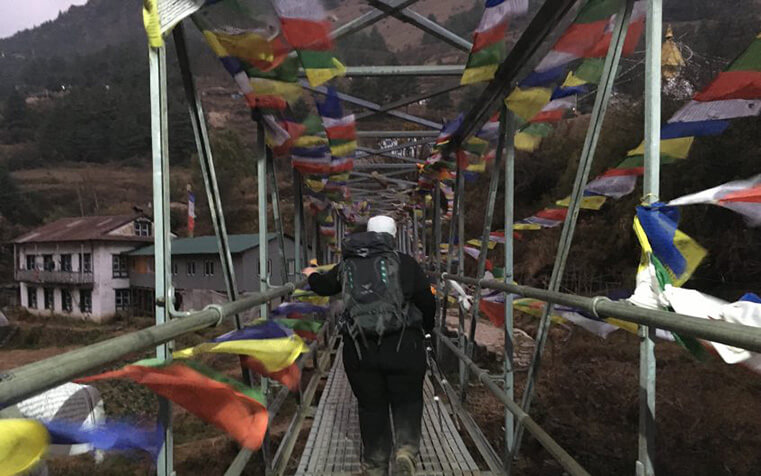In November 2018, 8 Wise Women Walkers joined me to head to soulful Nepal for some soul revival time and a bit of adventure. The goal was to experience some low altitude trekking in the quieter Solu Region of the Himalaya’s as well as learn more about the Buddhist way of life in rural Nepal with daily yoga and meditation practice while staying at monasteries. We also had the opportunity to visit a PHASE Nepal project. Our team had collectively fundraised just over $4700 for Himalayan Development Foundation Australia and via PHASE Nepal we would have a homestay experience and tour of the villages in the Buruwa area.
Everything in Nepal takes time, whether it’s a shop visit, taxi ride in thick traffic or getting through the airport – every part of this travelling experience can seem like an adventure and something beyond the comforts of home. The frenetic energy and atmosphere of being in a country that has more people than the roads, buildings and infrastructure can cope, is the norm in Nepal. I think that’s why I love this country – the lesson is to slow down because you cannot go quicker. Fighting it is a losing battle, you just have to go with the flow…..
KATHMANDU
On arrival in Kathmandu, after making our way through the visa process and immigration queues, we were whisked away to our guest house at Neydo Monastery. It was midnight by the time we arrived to a late supper that our hosts had waiting for us. Upon waking in the morning, we could take in the hills of the outer suburbs of Kathmandu. It was quiet and nothing like the chaos of Kathmandu city that I remembered from 2016, but still had the odd barking dog, tooting horn and chanting Monks reminding me we were in Nepal.
While we had missed the early morning prayer ceremony, puja, we listened to a talk on Buddhism by Sange Lama in the temple. It was an introduction to the way of the life of the many monks who live at the monastery as well as the Buddhist principles they follow on the journey to enlightenment. He made us laugh, telling us why he wanted to become a monk as a youngster (yes it was fashion envy back then) and how he had lived here since the age of 9. His talk was informative and started the curiosity for many of us wanting to learn more.
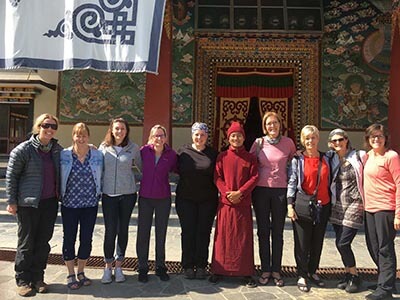
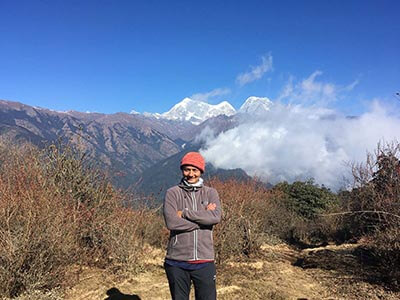
Meghsha our yoga teacher and guide (pictured above) introduced small practises and teachings to some of our yoga sessions to enhance the connection time both during yoga and during our trek and time in Nepal. This truly added to the practise of reflection each day and inspired my journaling each day.
We headed out for a walk that afternoon and visited a local nunnery where young girls were singing their lessons. Unfortunately, the amazing nun Ani Choying Drolma, who started this school was not present but she is widely known as being a Goodwill Ambassador for Unicef and she is a well-known musician and singer. Her uplifting Tibetan Buddhist chants can be checked out here
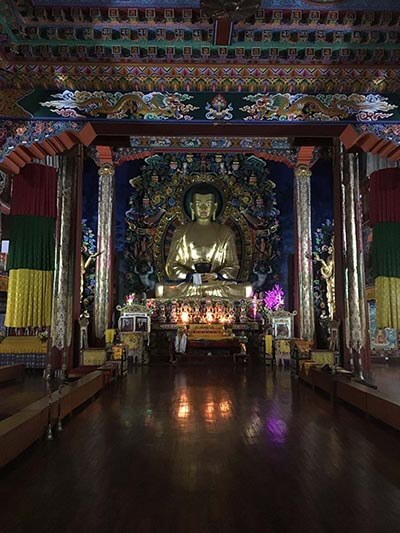
The following morning, we got up at 5am to experience our first puja. We were encouraged to sit at the back of the Temple and watch and listen. The chanting, the horns and the drums were vibrating through my body as I closed my eyes to absorb this unique and special experience. We learned this is exactly why musical instruments are used. To enhance the vibration for positive prayer outcomes throughout the ceremony.
Our sunrise yoga session followed where a series of joint releasing exercises brought comfort, routine and a sense of connection to the physical self and our minds which we were able to experience almost daily, sometimes twice a day on our trip thanks to our caring guide Meghsha.
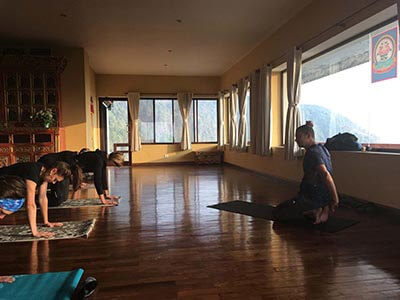
We travelled into Kathmandu to meet another local guide to take in the UNESCO sites of Patan, Swayambhunath (also known as the monkey temple) and finished off with a late lunch overlooking the stunning Boudanath Stupa. My favourite place in Kathmandu is this Stupa. It’s huge and beautiful, bringing pilgrims and worshippers from all over the world, to do their customary two laps, spinning the prayer wheels or completing a full routine of body to ground movement for prayer.
We checked into our guest house accommodation, a short walk from the Stupa and had a pre-trek briefing ready for departure the next day. The excitement and nerves built as we listened to our Sherpa guide Gelu, explain the cooler overnight temperatures (-10 degrees!), the trek itself and luggage allowances for the small plane flight.
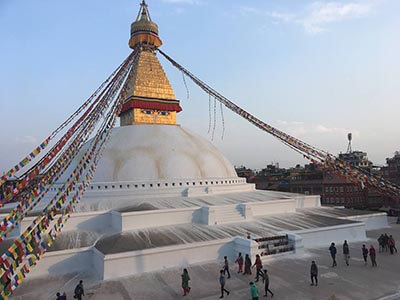
THE TREK
With a sunrise roof top session of sunrise yoga overlooking the Stupa, we felt energised somewhat for the day ahead. A hasty check-in, bag weigh and security process/pat down, saw us in the departure lounge of the domestic airport waiting for our flight to be called.
Thankfully our flight was only an hour or so late, mostly smooth and with clear skies. The approach to Phaplu airport though was hairy as we coasted above trees we felt we could reach out and touch (!) but the views of those snow cappies had many of us in complete awe. The adrenalin rush after a big build up was over and we headed uphill to our teahouse breathing in the slightly thinner air. We were now at elevation 2413 metres. We sat in a cosy teahouse, had our duffel bags divided up among the porters and ordered lunch, mentally prepared ourselves for an afternoon hike to Junbesi.
The trek was mostly downhill to begin with to a huge suspension bridge that crossed the Solucalu River – another test of fear around heights, this bridge is long and high! Our journey was mostly on widish tracks and roads past farmers carrying their fields with bulls or nuns heading back to the Thuptencholing monastery up the hill, almost skipping past us “non-mountain dwelling un-acclimatised to altitude” folk.
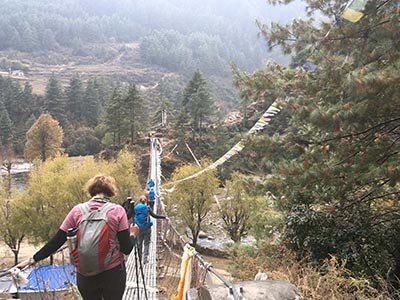
We arrived to our Junbesi teahouse, elevation 2617 metres, just on dusk, to a warm shared dining area. Once out of our hiking clothes and into our warm layers of thermal and puffy wear, we enjoyed hot tea, (ginger, lemon, honey being a firm favourite) and birthday celebrations for one of our awesome Wise Women Walker’s. Dinner followed by a surprise birthday cake and then the children of the teahouse owner’s and staff, performed a couple of gorgeous dance routines to Bollywood-style tunes. My cheeks and jaw were hurting from smiling and a happy tear or two may have snuck from my eyelids. Pure joy.
The first time in a teahouse is always a new experience – getting used to communal bathrooms, irregular plumbing, squat toilets, no showers, icy tap water, basic bedding in cosy bedrooms and ordering your next meal and hot drink straight after your current meal – you gradually acclimatise to Nepali teahouse routines. All meals are prepared from scratch and with big groups, and only the one kitchen with limited facilities, it’s incredible to see the variety on the menu! Momos, pasta, rice, potatoes, soups, stews even pizza!
The next day began with a sunrise yoga session in our full thermal gear, gloves and beanie layers in sub-zero temperatures. We released joints, did sun salutations, willing the suns rays to warm us up until blood flowed eventually to the extremities, well almost. The prayer wheel out the front of our tea house spun as locals passed by, watching us mid-pose and giggling.
Our day today would be a trek uphill to Thuptencholing Monastery, where both monks and nuns live in worship and sanctity. The trek there was uphill but just before we left the teahouse, Gelu pulled me aside and said the Ringpoche Dhulchik was in the temple today at the monastery, so we would buy scarves to be blessed at the temple during prayer ceremony. This was not guaranteed but a request would be made and we all hoped for the best. Anticipation and excitement built as we learned this 4-year-old child was the 33rd re-incarnate of Ringpoche Dhulchik. Far out!!!
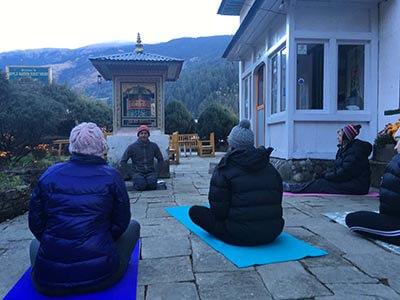
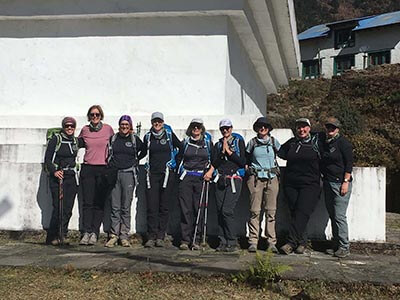
The trek uphill challenged me today because I had what I would describe as my usual acclimatisation headache. I kept the fluids up and battled on with another Wise Woman also with the same headache! Although, even though our trek is considered low altitude, some of us still experience symptoms of acclimatisation. Headache is common, breathlessness and difficulty sleeping are the usual signs of the body adjusting to lack of oxygen. The key is to slow right down and breathe deeply.
Once we arrived at the monastery sitting at 3000m, it was discovered we were in luck – Gelu, our awesome Sherpa guide was successful with his request. We dutifully lined up after taking off our shoes, removing our hats and headwear and headed into the temple. One by one we were blessed by the Ringpoche, who was a little bit tired and a little bit sleepy! It was a truly humbling experience and there were tears of overwhelm, awe and joy. We sat outside in the sun to pause and process what had just happened. The nuns sat with some of our group to look at photos and communicate with big smiles.
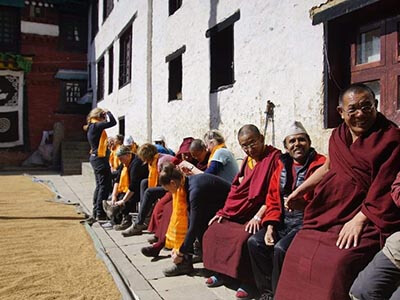
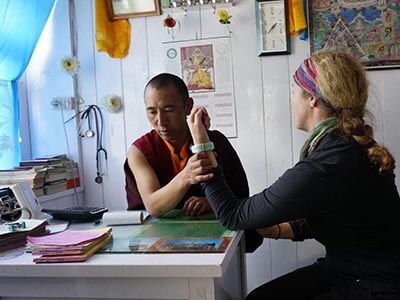
We were invited to lunch in the Monastery where we enjoyed a traditional Dal Bhat with the nuns and monks. It was the most delicious I’d eaten. But our excitement for the day was not yet over. We headed down the hill past the school where boys were shaving their heads in the school yard to the Tibetan Medical Centre. Here the Ahchee (doctor) did pulse readings and blood pressure readings before announcing his findings and if there were any remedies or herbs that would help, he would prescribe them to us. One by one we sat in the chair, it took 5-10 minutes for each person and it was honestly like talking to a healer who could see inside your soul. The findings were fairly accurate with many of us identifying with his suggestions to look after our bodies, keep away from the carbs, tea or stress. He also identified anxiety, sleep issues and perfectionism. With herbs and remedies, we returned down the hill to our teahouse for an evening meditation by candlelight before dinner. It had been a big day on so many levels. To bring it all together into relaxation and meditation rounded off a memorable Nepali experience beautifully.
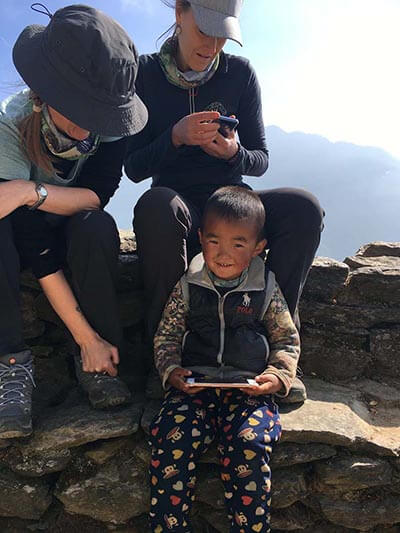
Our next trekking day was going to be a longer one, from Junbesi we would head to Taksindu and if the skies were clear, we would be lucky to see a view of Everest. A slow and steady climb through gorgeous forest again, once above the trees we had magnificent views of the valleys below. We rounded the mountain reaching a rest spot where a budding photographer, also the cutest little kid around, wanted to take our pictures with a backdrop of snow-capped mountains in the distance which was just awesome.
In sunshine we continued just a little further to our early lunch spot. After lunch the trail initially weaved downhill across the river and then up, up, up to Taksindu. It was a walking day I’ll remember for its long, deep and meaningful conversations about the people who inspire us and who are no longer with us. Tears snuck out. I always feel closer to them in the mountains. The climb challenged many with the thinner air and the setting sun, so I found my playlist and a tune to lift the spirits and celebrate the views. We reached Taksindu Pass just over 3000m and from here it was just half hour downhill to the teahouse and monastery, where we would spend the night. We arrived to the cosiest little teahouse (ever) in time for evening Puja and we did gentle yoga outside the temple to the sounds of chanting monks and musical instruments, before the rain started and we abandoned our night time session. Our teahouse kitchen was right in the dining area, it was a wonderful opportunity to sit, play cards, laugh and meet other trekkers.
Being off the grid on trekking days is such a gift. Phone coverage is almost non-existent, there is little to no wifi and screen time is just not necessary. To switch off from home, the hustle and bustle and being totally present in the moment, is something to treasure in the Himalaya’s. Conversation, presence and connection to the here and now is something really hard to achieve when on the grid.
With our biggest trekking day ahead, we decided to make an early start, skip sunrise yoga and make our way to Chiwong Gompa. There are three trails to choose from to get to Chiwong Gompa – high, medium and low. The ridge trail is higher in altitude and has the best chance of views, so we headed high! The icicles still laid in delicate positions in the morning waiting for the sun to hit them and melt. Through forest and clearings, we rounded an old Stupa with a postcard backdrop of snow-capped mountains. Being at 3600 metres is a harder trek for us sea-level dwellers and it was felt by many of our Wise Women whether it was breathlessness, headache or a little light headedness.
Everyone did a fantastic job despite the experience being far outside a known comfort zone. We picnicked on boiled eggs and chapati bread, potatoes and apples in the sun, as cloud formations floated above us. The long day pushed many physically and mentally and the steep, steep arrival on slippery narrow paths, had bodies and minds at their limit. It was a relief to arrive all in one piece to Chiwong Gompa, elevation 2750 metres to hot tea, biscuits and a chance to rest. A yoga session that evening was in a courtyard area in the monastery ground right by our rooms as the sun set. Our evening meal was the best Dal Bhat on our trip, matching that of Thuptencholing Monastery and the cards came out as we gathered around an indoor coal heater brought in by our caring guides Gelu, Fuba and Meghsha, to keep the chill out.
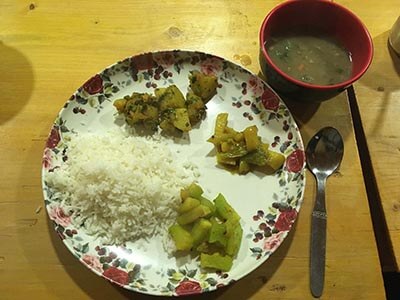
Our final day of trekking meant returning to Phaplu, all downhill and only two hours of walking. We had our sunrise yoga session in the courtyard and a simple breakfast of Tibetan bread, potatoes and tea before our downhill journey began. We passed school kids on their way up to school on the hillside and farmers working their fields. It’s not until you walk down the steep path from Chiwong Gompa that you realise the magnificent mountainside location of this monastery, perched on a ridge and often above the cloud. An idyllic location of worship and isolation. Once back in Phaplu, many celebrated with a warm to hot shower, lunch, Uno championships and of course a lengthy yoga and meditation session. We also got the chance to thank our porters and guides for looking after us.

Our return to Kathmandu included an extended scenic flight back, lucky for us it was a clear day, smooth flying and oh so scenic. It’s always a relief to land though and back to the chaos of Kathmandu, with the car horns, people, cars, cows, dogs and motorbikes.
We checked in to a bit of an upgraded hotel compared to our basic teahouse lodgings for that long-awaited shower and big lunch. This afternoon was our only chance to head to Thamel for shopping and singing bowls were high on the shopping list. It was a frenetic shopping experience and ninety minutes just flew. We then experienced a peak-hour drive across town back to our hotel for a late dinner and wander around Boudanath Stupa by night.
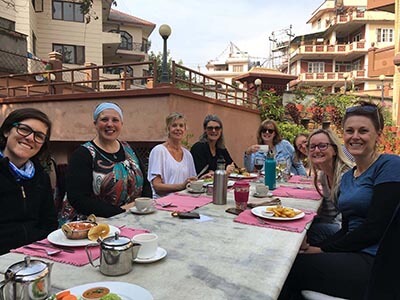
BURUWA
Our yoga session the next day was on the rooftop of our hotel as the sun rose over Kathmandu. With just 2 nights left, we would undergo an adventurous thirty hours driving deep into mountainside villages, to stay with families and see the projects funded through Himalayan Development Foundation Australia via PHASE Nepal. The projects included building greenhouses, a mushroom farm, fruit trees, medical clinic and school rebuild.
The 6+ hour drive was unbelievable on those mountain roads, the welcome by the villages was something I’ll never forget. An opening blessing and prayer, dye dots on our foreheads, head scarves and marigold flowers from the children. By this time, it was dark and late so after a quick tour of the medical clinic. we were ushered to our host families and offered dinner – eggs, Dal Bhat and tea – so much tea.
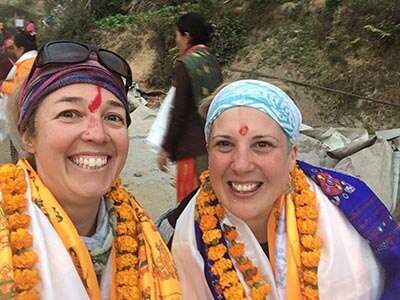

The warm hospitality, despite many families living in temporary shelter still post-earthquake was humbling. Our beautiful hosts were keen to ensure we were comfortable and warm enough. We had to cut the village tour experience short the following day due to time constraints and a few injuries/illness with our team (I had an embarrassing fall injuring my foot) but we managed to see numerous greenhouses and the medical clinic which the local people were so proud to share. We were invited to try Tamang butter tea, which is made of ghee, salt and water and also to stay on for a post-funeral feast, but we had to keep moving, visiting Simpiani school on our way back to Kathmandu, which was re-built post-earthquake thanks to PHASE Nepal funding. They are now hoping to fence the area surrounding the building as it is on a mountain face so that the kids can play ball games. I can’t help but think we can raise more funds and make even more of a difference to the lives of those who live there.
Arriving back into Kathmandu, we all enjoyed our final dinner together, reflecting on how we felt about the immersive and sometimes challenging experiences of culture, trekking, home stay and small plane flights as well getting outside our comfort zone. The moments of reflection through the yoga and meditation were an opportunity to break the pace of trekking and travelling.
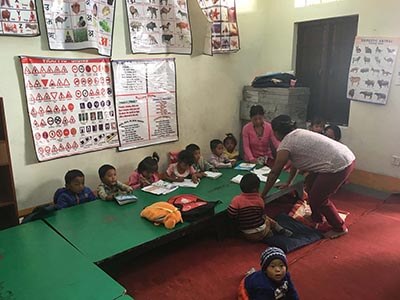
Massive thanks and gratitude to Meghsha, Gelu and Fuba for looking after us both on and off the trails, ensuring our visit to Nepal was a happy and fulfilling one.
Massive thanks and gratitude also to an amazing bunch of Wise Women Walkers who took on the adventure, challenged themselves and gave themselves the gift of connection time.
I can’t wait to return next year…
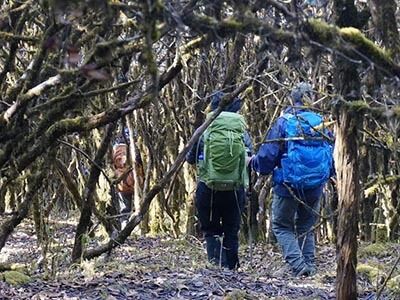
Lisa is an experienced and qualified outdoor leader, travel agent and adventure traveller. She hosts Wise Women Walking tours to Nepal once a year sharing the opportunity to trek on trails less travelled and experience a taste of Buddhist lifestyle in rural Nepal offering women the chance to digitally disconnect and reconnect with themselves. Head to our Wise Women Walking page for upcoming trips.
Additional Reading
For more information on our women’s walking group ‘Wise Women Walking’ visit our website here.
To see all our South Australian walking tours, visit our website here.
You can check out all our other walking tours here.
To learn more about ‘Big Heart Adventures’ and wellness walking, visit our website here.

